Research - (2022) Volume 10, Issue 5
Correlation between Chewing Side Preference, Handedness and Dental Caries in Primary, Mixed and Permanent Dentition
Janvi M Gandhi* and Vignesh Ravindran
*Correspondence: Janvi M Gandhi, Department of Pediatric and Preventive Dentistry, Saveetha Institute Of Medical and Technical Sciences, Saveetha University, Chennai, India, Email:
Abstract
Introduction: Chewing side preference of a person occurs when mastication is performed consistently on the same side [right or left]. Early diagnosis of a preferred chewing side [PCS] plays a significant role in occurrence of dental caries, craniofacial development, occlusal harmony and may prevent unilateral chewing patterns. Handedness of a person [right or left] can also be related to his/her chewing side preference.
Materials and Methods: This study included 45 subjects; Group A, 15 children 3-5 years [primary dentition], Group B, 15 children 6-12 years [mixed dentition], Group C, 15 children 13-18 years [permanent dentition]. Chewing side preference test and laterality test was done and deft/DMFT index was recorded in all the subjects. Correlations between chewing side and handedness and caries index and chewing side were assessed by chi-square test and phi correlation tests at a level of significance of 0.05 or 5%.
Results: There was a statistical significance between chewing side preference and age. No statistical significance between chewing side and handedness, although there was a statistical significance between chewing side and caries index.
Conclusion: Evaluation of chewing side preference should be a part of routine dental examinations, especially in primary and mixed dentitions as unilateral chewing pattern can lead to various consequences in the stomatognathic system in adulthood.
Keywords
Chewing side preference, Handedness, Hemispheric laterality, Mixed dentition, Primary dentition, Permanent dentition
Introduction
Lateral dominance of a person can be determined by sidedness, such as right handedness or left handedness. According to Nissan et al [1], hemispheric laterality relates to the central hemisphere of the brain, which determines laterality in the function of peripheral organs. Handedness of a person can also be related to his/her chewing side preference. Chewing side preference of a person occurs when mastication is performed consistently on the same side [right or left]. If both sides are equally efficient then chewing occurs on both sides. The presence of a preferred chewing side may have implications for the production and distribution of saliva around the mouth. It may explain the aggregated or clustered caries patterns [Hujoel et al] [Hannigan et al]. It has been reported that 50-83% of adults have a preferred chewing side. Early diagnosis of preferred chewing side [PCS] plays a significant role in occurrence of dental caries, craniofacial development, occlusal harmony and may prevent the unilateral chewing pattern from triggering various consequences in the stomatognathic system in adulthood like TMJ disorders.
Most studies tried to assess the correlation between chewing side preference and handedness in adult subjects [Hoogmartens and Caubergh] [Christensen and Radue]. No correlation between the two was noticed in the adult population.
There is no previous research done on the correlation between chewing side preference, handedness and dental caries in children. This study includes children belonging to the primary, mixed and permanent dentition. Early diagnosis of CSP plays a significant role in dental caries occurrence, eruption of teeth, orofacial muscle development, occlusal harmony and craniofacial development. Hence the aim of this study was to find a correlation between preferred chewing side, handedness and dental caries in primary, mixed and permanent dentition.
Materials and Methods
This study was done in a university setting and ethical approval was obtained from the Institutional Review Board, Saveetha Institute of Medical and Technical Sciences. The study population was children aged 3 years to 18 years [3-5 years old-primary dentition, 6-12 years old-mixed dentition and 12-18 years old- permanent dentition]. A sample of 45 participants were selected for this study following the inclusion criteria of children with good general health; children without neurological disorders, children with primary dentition >15 teeth and subjects with permanent dentition >24 teeth. Exclusion criteria were subjects who were not willing to participate and those with dentofacial swelling, tenderness to percussion. DMFT/deft index was also scored for each participant. The study population was segregated into 3 groups based on their dentition status.
Group A [15]- Children with Primary dentition Group B [15]- Children with Mixed dentition Group C [15]-Children with Permanent dentition
Chewing side preference test
Chewing side preference was tested using a method according to Mc Donnell et al. [2]. Participants were given one piece of chewing gum [sugar-free] and were asked to chew. After a 15second time interval, the subjects were asked to stop chewing and to smile in order to observe which side the chewing gum is placed. The same was repeated 5 times in each participant with a time interval of 5 seconds between each chewing cycle.
The chewing side preferences [CSP] were classified according to the following criteria:
Consistent preferred chewing side [CPCS] - 5/5 strokes on same side.
Predominant preferred chewing side [PPCS] - 5/7 or 6/7 strokes on the same side.
Observed preferred chewing side [OPCS] - 5/7, 6/7 or 7/7 strokes on the same side (Figure 1).
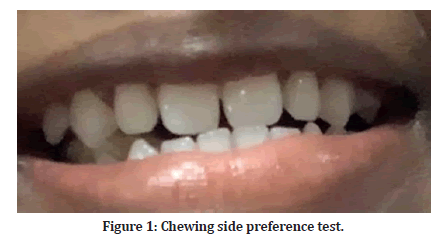
Figure 1: chewing side preference test.
Laterality tests
Handedness of the subject was checked by asking them to perform tasks like making a drawing and throwing a ball. All the subjects performed each task twice and the hand used predominantly was chosen as the dominant hand of that person; indicating whether he/she is righthanded or left-handed (Figure 2).
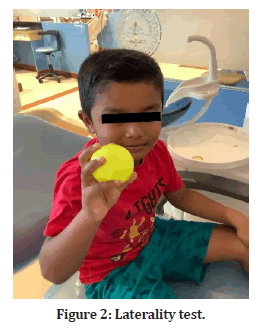
Figure 2: Laterality test.
DMFT/deft measurement
D/d- Decayed teeth
M/e- Missing or extracted due to caries.
F/f- Filled teeth
All the teeth were scored and a total DMFT/deft score was obtained. For primary teeth, the maximum deft score for an individual would be 20 and for permanent teeth the maximum DMFT score would be 28 as third molars are excluded.
Statistical Analysis
All the analyses were carried out using IBM SPSS version 23.0 IBM Corporation, NY, USA. Correlations between chewing side and handedness and caries index and chewing side were assessed by Chi-square test at a level of significance of 0.05 or 5%. Correlations were also done between chewing side preference and age and handedness and age. The strength of the correlation was assessed by the phi correlation coefficient.
Results
A total of 45 children were included in this study, 15 in each group with the age group of 3-18 years. Each group had 7 male and 8 female participants. Among the different age groups, 5 year old children were found to have the right side as the preferred chewing side and 10 and 17 year old children preferred the left side. 4-yearold children preferred to chew on both sides (Figure 3).
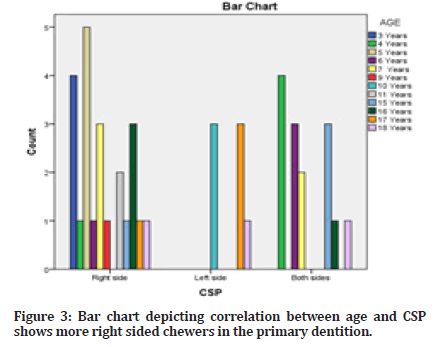
Figure 3:Bar chart depicting correlation between age and CSP shows more right sided chewers in the primary dentition.
It was found that most of the children included [primary, mixed and permanent dentition] in this study were right handed (Figure 4).
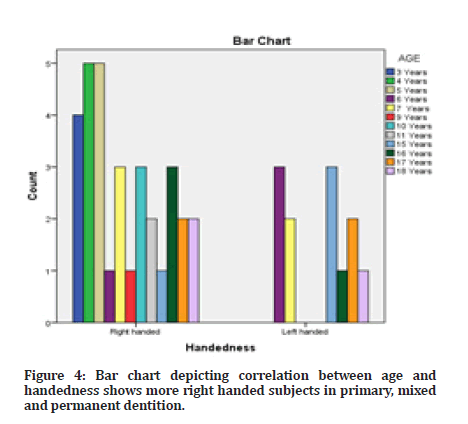
Figure 4:Bar chart depicting correlation between age and handedness shows more right handed subjects in primary, mixed and permanent dentition.
DMFT/deft index was found to be more prevalent on the right side as the preferred chewing side [PPCS] (Figure 5).
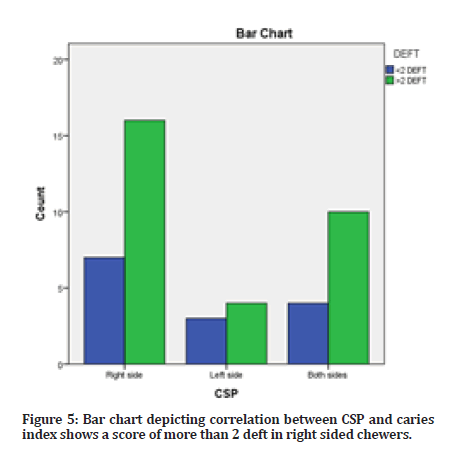
Figure 5:Bar chart depicting correlation between CSP and caries index shows a score of more than 2 deft in right sided chewers.
Discussion
This study investigated whether there is any correlation between handedness of a person, chewing side preference and dental caries. In this study there were very few number of children who preferred to chew on the left side, most of the participants included in this study had the right side as their PPCS, these results are in agreement with some previous studies [3] except a few children who had pain on the right side due to decayed teeth with reversible/irreversible pulpitis. More right sided chewers may also be because this study included an unequal number of right-handed and lefthanded participants, which was one of the limitations of this study. It was also found that a higher prevalence of a preferred chewing side was seen in children as they would usually prefer to chew on one side as they have difficulty moving a bolus from one side of the mouth to the other [4]. It may indicate that the masticatory efficiency of children in the mixed dentition stage is decreased. It was also noted that the presence of pathology in absence of pain does not influence preferred chewing side. The results of this study provide some evidence to suggest that pain has an influence on the PPCS in children and having a PPCS may indicate poor masticatory efficiency.
In this study, the distribution of PPCS in children with primary dentition was 62% to the right and 38% to the left; in children with mixed dentition stage it was 57% to the right and 43% to the left; and in subjects with permanent dentition it was 54% to the right and 46% to the left. These results coincide with the findings of [3,5].
Chewing preference or preferred chewing side is a centrally controlled, innate quality and can be affected by social and personal learning or other factors. The right side being chosen generally, irrespective of the peripheral factors indicates that chewing preference may be determined by central nervous system mechanisms [6].
A study [2] compared the chewing side preferences in children according to age and gender. There was no proven relationship between age and gender and existence of a PPCS in children. This study did not correlate gender of the participants with the chewing side preference whereas [2] found that males tended to exhibit CPCSs and females tended to exhibit PPCSs. Another study [5] investigated whether there is any association between chewing side preference and the distribution of sidedness [hand, foot, eye and ear] in primary, mixed and permanent dentition and a significant correlation was found between handedness and mixed dentition. They also concluded that the tendency to prefer the right side for chewing predominates over the other side in primary, mixed and permanent dentition. They also found that chewing side preference can be significantly associated with handedness and footedness for mixed dentition and handedness, footedness and earedness for permanent dentition but these were found to be weak correlations. These studies were in agreement with the results obtained in our study. Whereas other studies [1, 7] showed a strong correlation between chewing side preference and lateral dominance.
The limitations of this study are the lesser sample size in each group and the unequal distribution of right-handed and left-handed participants. Future studies should be done with a larger sample size and more inclusion of lefthanded participants. The null hypothesis was partially rejected because there was a significant correlation between chewing side preference and DMFT/deft index but there was no correlation between chewing side preference and handedness.
Evaluation of chewing side preference should be a part of routine dental examinations, especially in primary and mixed dentitions as unilateral chewing pattern can lead to various consequences in the stomatognathic system in adulthood like TMJ disorders [8].
Conclusion
Within the limitations of this study, it can be concluded that there is a significance between preferred chewing side and the caries index. Evaluation of chewing side preference should be a part of routine dental examinations, especially in primary and mixed dentitions.
Conflicts of Interest
There are no conflicts of interest.
References
- Nissan J, Gross MD, Shifman A, et al. Chewing side preference as a type of hemispheric laterality. J Oral Rehabil 2004; 31:412-6.
- Mc Donnell ST, Hector MP, Hannigan A. Chewing side preferences in children. J Oral Rehabil 2004; 31:855-60.
- Manly RS, Shiere FR. The effect of dental deficiency on mastication and food preference. Oral Surg Oral Med Oral Pathol 1950; 3:674-85.
- Gisel EG. Development of oral side preference during chewing and its relation to hand preference in normal 2-to 8-year-old children. Am J Occup Ther 1988; 42:378-83.
- Barcellos DC, Da Silva MA, Batista GR, et al. Absence or weak correlation between chewing side preference and lateralities in primary, mixed and permanent dentition. Arch Oral Biol 2012; 57:1086-92.
- Diernberger S, Bernhardt O, Schwahn C, et al. Self‐reported chewing side preference and its associations with occlusal, temporomandibular and prosthodontic factors: results from the population‐based Study of Health in Pomerania (SHIP‐0). J Oral Rehabil 2008; 35:613-20.
- Nissan J, Berman O, Gross O, et al. The influence of partial implant‐supported restorations on chewing side preference. J Oral Rehabili 2011; 38:165-9.
- Santana-Mora U, López-Cedrún J, Mora MJ, et al. Temporomandibular disorders: the habitual chewing side syndrome. PloS one 2013; 8:e59980.
Indexed at, Google Scholar, Cross Ref
Indexed at, Google Scholar, Cross Ref
Indexed at, Google Scholar, Cross Ref
Indexed at, Google Scholar, Cross Ref
Indexed at, Google Scholar, Cross Ref
Indexed at, Google Scholar, Cross Ref
Indexed at, Google Scholar, Cross Ref
Author Info
Janvi M Gandhi* and Vignesh Ravindran
Department of Pediatric and Preventive Dentistry, Saveetha Institute Of Medical and Technical Sciences, Saveetha University, Chennai, IndiaCitation: Janvi M Gandhi, Vignesh Ravindran, Correlation Between Chewing Side Preference, Handedness and Dental Caries in Primary, Mixed and Permanent Dentition, J Res Med Dent Sci, 2022, 10 (5):70-73.
Received: 29-Apr-2022, Manuscript No. JRMDS-22-60855; , Pre QC No. JRMDS-22-60855 (PQ); Editor assigned: 02-May-2022, Pre QC No. JRMDS-22-60855 (PQ); Reviewed: 16-May-2022, QC No. JRMDS-22-60855; Revised: 20-May-2022, Manuscript No. JRMDS-22-60855 (R); Published: 27-May-2022
